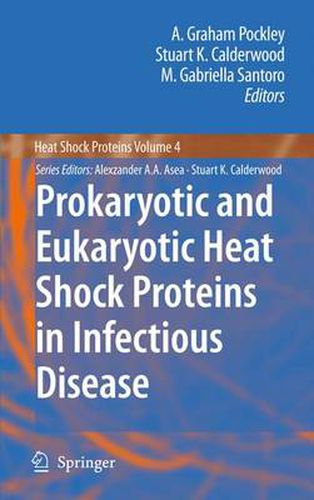Readings Newsletter
Become a Readings Member to make your shopping experience even easier.
Sign in or sign up for free!
You’re not far away from qualifying for FREE standard shipping within Australia
You’ve qualified for FREE standard shipping within Australia
The cart is loading…






This title is printed to order. This book may have been self-published. If so, we cannot guarantee the quality of the content. In the main most books will have gone through the editing process however some may not. We therefore suggest that you be aware of this before ordering this book. If in doubt check either the author or publisher’s details as we are unable to accept any returns unless they are faulty. Please contact us if you have any questions.
Prokaryotic and Eukaryotic Heat Shock Proteins in Infectious Disease provides the most current review of the literature relating to the role and influence of heat shock (stress) proteins on the establishment, progression and resolution of infectious disease. Written by leaders in the field of heat shock proteins (HSP) and their biological and immunological properties, the contributors provide a fascinating insight into the complex relationship between, and the involvement of prokaryotic and eukaryotic HSP in disease states. It has been known for some considerable time that heat shock proteins from prokaryotic organisms are immunodominant molecules that are intimately involved in the induction of potential protective inflammatory responses, and this aspect of HSP biology is updated herein. In addition to regulating heat shock protein gene expression, the transcription factor HSF1 also appears to play an important role in regulating immune responses to infection. Heat shock proteins are now known to influence infectious disease processes in a number of diverse ways: they are involved in the propagation of prions, the replication and morphogenesis of viruses, and the resistance of parasites to chemotherapy. These proteins also appear to be important mediators of bacteria-host interactions and inflammation, the latter via interactions with cell surface molecules and structures such as Toll-like receptors and lipid rafts. Heat shock proteins can be expressed on the surface of infected cells, and this is likely to provide a target for the innate immune response. Elevated levels of circulating HSP are present in infectious diseases and these proteins might therefore regulate inflammatory responses to pathogenic challenge on a systemic basis. Heat shock proteins are also implicated in the impact of genital tract infections on the reproductive outcome, as well as in the local and systemic consequences of periodontal disease. Fever-range temperatures can induce the expression of heat shock proteins, and the final chapter in the book examines the influence of fever-range hyperthermia on a variety of cells and the organization of plasma membranes. This book is an essential read for graduates and postgraduates in Biology, pro- and eukaryotic Biochemistry, Immunology, Microbiology, Inflammatory and Infectious Disease, and Pathology.
$9.00 standard shipping within Australia
FREE standard shipping within Australia for orders over $100.00
Express & International shipping calculated at checkout
This title is printed to order. This book may have been self-published. If so, we cannot guarantee the quality of the content. In the main most books will have gone through the editing process however some may not. We therefore suggest that you be aware of this before ordering this book. If in doubt check either the author or publisher’s details as we are unable to accept any returns unless they are faulty. Please contact us if you have any questions.
Prokaryotic and Eukaryotic Heat Shock Proteins in Infectious Disease provides the most current review of the literature relating to the role and influence of heat shock (stress) proteins on the establishment, progression and resolution of infectious disease. Written by leaders in the field of heat shock proteins (HSP) and their biological and immunological properties, the contributors provide a fascinating insight into the complex relationship between, and the involvement of prokaryotic and eukaryotic HSP in disease states. It has been known for some considerable time that heat shock proteins from prokaryotic organisms are immunodominant molecules that are intimately involved in the induction of potential protective inflammatory responses, and this aspect of HSP biology is updated herein. In addition to regulating heat shock protein gene expression, the transcription factor HSF1 also appears to play an important role in regulating immune responses to infection. Heat shock proteins are now known to influence infectious disease processes in a number of diverse ways: they are involved in the propagation of prions, the replication and morphogenesis of viruses, and the resistance of parasites to chemotherapy. These proteins also appear to be important mediators of bacteria-host interactions and inflammation, the latter via interactions with cell surface molecules and structures such as Toll-like receptors and lipid rafts. Heat shock proteins can be expressed on the surface of infected cells, and this is likely to provide a target for the innate immune response. Elevated levels of circulating HSP are present in infectious diseases and these proteins might therefore regulate inflammatory responses to pathogenic challenge on a systemic basis. Heat shock proteins are also implicated in the impact of genital tract infections on the reproductive outcome, as well as in the local and systemic consequences of periodontal disease. Fever-range temperatures can induce the expression of heat shock proteins, and the final chapter in the book examines the influence of fever-range hyperthermia on a variety of cells and the organization of plasma membranes. This book is an essential read for graduates and postgraduates in Biology, pro- and eukaryotic Biochemistry, Immunology, Microbiology, Inflammatory and Infectious Disease, and Pathology.